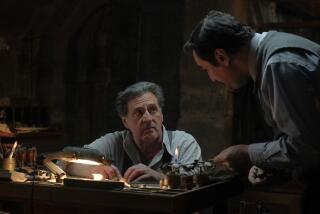Book review: Jules Verne’s ‘The Secret of Wilhem Storitz’
There ought to be a law stipulating that well-meaning relatives may not touch the manuscripts left by their loved ones. It traumatizes a book to have its ending Disneyfied, its time period altered by 100 years, its nouns and adjectives translated back and forth across time and languages. This was the circuitous journey that Jules Verne’s last great opus, “The Secret of Wilhem Storitz,” took before landing on our shores, where it has been revived and returned to its authentic form by Peter Schulman and the University of Nebraska Press.
Eight unfinished manuscripts were left in the hands of Verne’s son, Michel, when Verne died in 1905. Michel slapped on a happy ending and removed the gorgeous digressions. It was translated into English from the original French in 1963, but this was a translation of Michel’s version, not his father’s original, which we now have the opportunity to read.
Thank goodness, for it is a thrilling, evocative novel — ringing with Hungarian Gypsy music, shot through with the presence of evil and raising tingles as it teeters along the precipitous drop on either side of the narrow path that we humans walk.
The main character in this story, Wilhelm Storitz, is Prussian. Verne had no love for the Prussians or the Germans and — after the Franco-Prussian War — he barely spoke of them without making reference to their barbarity. This hatred was considerably watered down in the version put forth by his son.
In Schulman’s translation of the work, Storitz knew love and the possibility of redemption.
But when his beautiful fiancée, Myra, is betrothed to a painter Storitz develops a potion that makes him invisible. He haunts the Hungarian town in which she lives, at every turn attempting to prevent the coming marriage.
The novel is narrated by Myra’s brother, who travels up the Danube River to Ragzi to attend the wedding. The haunting begins on the ship, where he is ominously shadowed by Storitz’s servant, Hermann. Verne describes this journey like an old-fashioned explorer (naturalist, geographer and poet). All movements lead to discovery, the future unpacked.
From the moment our traveler arrives in Ragzi the invisible man, Storitz, begins his appearances at dinners and other wedding-related functions leading up to the main event, shredding flowers and howling and generally terrifying the good people of Ragzi.
Like Edgar Allan Poe and H.G. Wells, Verne makes a monster out of a man; the flip side of love turns out to beobsessive and dangerous. Like Wells and Poe (and certainly Mary Shelley), the author has compassion for the monster, who becomes a beauty-destroying creature and ruins the very thing he loves.
Verne is a master of the eerie; the craggy landscape, the streets of Budapest and Ragzi, the cowering townsfolk are vivid displays of the skills of a writer in his later years, when landscape is imbued with more meaning than passion. Verne’s timing is perfect: “The lights left no corner in shadow … and yet … there was no one there.” Between the light and shadow, the intake and exhalation, the novel glides forward like an unstoppable thing. The experience of reading “The Secret of Wilhelm Storitz” is more like watching the original Dracula than any book you’ve ever read.
Salter Reynolds is a Los Angeles writer.
More to Read
Sign up for our Book Club newsletter
Get the latest news, events and more from the Los Angeles Times Book Club, and help us get L.A. reading and talking.
You may occasionally receive promotional content from the Los Angeles Times.






